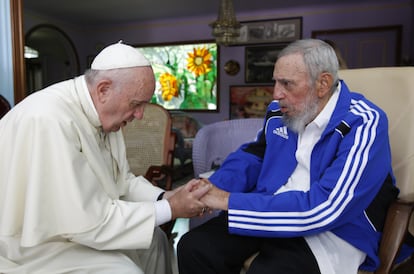The Pope who changed the geopolitical compass of the Catholic Church
Francis’ foreign policy put him at odds with Trump, brought him closer to China, alienated Israel, and was one of complex balances in Ukraine

The Argentine Cardinal Jorge Mario Bergoglio gave advance notice with his first words after assuming leadership of the Catholic Church in 2013 from the balcony of St. Peter’s Basilica: “You know that it was the duty of the Conclave to give Rome a Bishop. It seems that my brother Cardinals have gone to the ends of the earth to get one, but here we are.” That phrase, which aroused the sympathy and curiosity of the faithful, gradually took on meaning throughout a pontificate that decentralized the Church, removed it from its Eurocentric orbit, and oriented it towards the peripheries. From the beginning, the Pope sent signals in that direction. This was also true with the name he chose as pontiff, Francis, in honor of the saint who dedicated his life to serving the poor and those most in need.
Francis, a Jesuit with a strong missionary vocation, shook up the usual geopolitics of popes, shifting the focus from Europe as the linchpin of Catholicism and placing “the peripheries of the world” at the center of his teachings — one of the key themes of his pontificate, also in the existential sense, as he himself reiterated on numerous occasions. He has been one of the pontiffs most attentive to the global dimension of the Holy See.
In 2015, during his first extraordinary jubilee, dedicated to mercy, in an unprecedented gesture, he decided not to open the first Holy Door in Rome, the epicenter of the Church, but in the Central African Republic, a country he visited despite its being mired in a bloody civil war.
His first official trip was to the Italian island of Lampedusa in July 2013, at the time a symbol of the refugee crisis, where he denounced the “globalization of indifference” to the migratory plight of thousands of people who lost their lives at sea trying to reach European shores. His criticism of certain immigration policies was the main cause of tension with U.S. President Donald Trump over the dividing wall between the United States and Mexico he promised during his first term, and over the mass deportations during his second. “Whoever thinks of building walls and not bridges is not Catholic,” Francis said in 2016. He recently expressed his disagreement with the deportation policy, which “deteriorates human dignity.”
Approach to China
One of the milestones of Francis’s pontificate, convinced that the Church of the third millennium will grow in Asia, was the rapprochement with China, a country with enormous religious potential, coveted by his predecessors as well, where the Catholic Church was persecuted and relegated to the underground and which has not had diplomatic relations with the Holy See since 1951. In 2018, Bergoglio reached a historic agreement with Beijing that was key to beginning the thaw in relations between the two parties and basically consisted of reaching a consensus on the appointment of bishops. It was conceived as a test that has dragged on for years without reaching a stable and definitive agreement, and which has faced no shortage of controversy. Relations have not yet been restored, but it is a significant first step. Francis himself recently explained that relations between the two parties are “very respectful” and that channels of dialogue are open. The Vatican was keen to move on from the period of estrangement and conflict with a country where experts believe there are some 40 million Christians.
Francis has also focused on forgotten countries and conflicts and reached out to the peripheries through his apostolic trips. In Mexico’s Ciudad Juárez, a few kilometers from the U.S. border, he celebrated a historic Mass in 2016 and blessed a cross dedicated to the migrants risking their lives trying to reach the United States. In an Iraq in ruins and trying to recover from the ravages of the Islamic State (ISIS), he celebrated another Mass in 2021, as the first pontiff to set foot in that country. This Mass also served to reach out to the Christians there and to build bridges with Islam, another key focus of Francis’ pontificate. In 2019, he also became the first pope to visit the Arabian Peninsula, with a trip to the United Arab Emirates, which concluded with the signing of the Document on Human Fraternity for World Peace and Living Together with the Grand Imam of al-Azhar, Ahmed el-Tayeb, to strengthen dialogue between Christians and Muslims.
Mediation in Cuba
In 2019, he made an important trip to Japan, a special destination for Bergoglio, who in his youth dreamed of being a missionary there. The trip was loaded with symbolism, with visits to Hiroshima and Nagasaki and warnings about the danger of nuclear war. In 2017, he traveled to Colombia to offer his support for the government’s peace agreements with the FARC and to support the reconciliation process. In 2015, he traveled to Cuba and the United States to help unblock relations between the two countries. Then-U.S. President Barack Obama had directly asked Francis to mediate in establishing diplomatic relations with Cuba. The pontiff gave a historic speech in the U.S. Congress.
Francis had also proposed mediating between Russia and Ukraine, although in this case, Kyiv declined the offer for full-scale mediation, and the Kremlin did not respond. Ukrainian President Volodymyr Zelenskiy visited Francis in the Vatican and asked for diplomatic support for the release of Ukrainian detainees under Moscow’s control.
The Pope followed the conflict closely and sent a papal envoy on numerous occasions to monitor the progress of the conflict and try to foster dialogue between the two sides. He also sent humanitarian aid to Ukraine on countless occasions. Ukraine has repeatedly criticized some statements by the Pope. Last year, it criticized the Pope’s comments in an interview with Swiss television in which he stated that Kyiv should have the “courage” to negotiate an end to the war with Russia, which was interpreted as a call for Ukraine to surrender. The Vatican clarified shortly afterward that the Pope supported “a cessation of hostilities and a truce achieved through the courage of negotiations” and not an open surrender by Ukraine.
The pontiff’s position on the Israel-Palestine conflict has also been a delicate one. Francis, who has always defended the two-state solution proposed by the United Nations to end the Arab-Israeli conflict, harshly criticized Israel’s attacks on Gaza, calling them “immoral and disproportionate.” The pontiff even called for an investigation into whether a “genocide” was taking place in Gaza. Vatican diplomacy tries to avoid terms like genocide and terrorism and has sought to remain neutral in the conflict, limiting itself to calling for peace and the arrival of humanitarian aid for the civilian population, but there have been some tense moments, such as the one experienced after Francis’ double meeting with relatives of Israeli hostages taken by Hamas in the attacks of October 7, 2023, and with relatives of Palestinians affected by the war. The Palestinians said Francis had spoken of genocide during the private meeting, sparking a diplomatic uproar that underscored that Israel and the Holy See were experiencing the most tense period in their relations in recent decades.
Sign up for our weekly newsletter to get more English-language news coverage from EL PAÍS USA Edition
Tu suscripción se está usando en otro dispositivo
¿Quieres añadir otro usuario a tu suscripción?
Si continúas leyendo en este dispositivo, no se podrá leer en el otro.
FlechaTu suscripción se está usando en otro dispositivo y solo puedes acceder a EL PAÍS desde un dispositivo a la vez.
Si quieres compartir tu cuenta, cambia tu suscripción a la modalidad Premium, así podrás añadir otro usuario. Cada uno accederá con su propia cuenta de email, lo que os permitirá personalizar vuestra experiencia en EL PAÍS.
¿Tienes una suscripción de empresa? Accede aquí para contratar más cuentas.
En el caso de no saber quién está usando tu cuenta, te recomendamos cambiar tu contraseña aquí.
Si decides continuar compartiendo tu cuenta, este mensaje se mostrará en tu dispositivo y en el de la otra persona que está usando tu cuenta de forma indefinida, afectando a tu experiencia de lectura. Puedes consultar aquí los términos y condiciones de la suscripción digital.











































